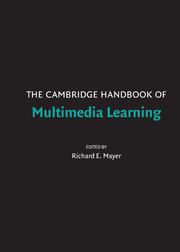Book contents
- Frontmatter
- Contents
- Preface
- Contributors
- 1 Introduction to Multimedia Learning
- PART I THEORETICAL FOUNDATIONS
- PART II BASIC PRINCIPLES OF MULTIMEDIA LEARNING
- PART III ADVANCED PRINCIPLES OF MULTIMEDIA LEARNING
- PART IV MULTIMEDIA LEARNING IN CONTENT AREAS
- PART V MULTIMEDIA LEARNING IN ADVANCED COMPUTER-BASED CONTEXTS
- Author Index
- Subject Index
- References
1 - Introduction to Multimedia Learning
Published online by Cambridge University Press: 05 June 2012
- Frontmatter
- Contents
- Preface
- Contributors
- 1 Introduction to Multimedia Learning
- PART I THEORETICAL FOUNDATIONS
- PART II BASIC PRINCIPLES OF MULTIMEDIA LEARNING
- PART III ADVANCED PRINCIPLES OF MULTIMEDIA LEARNING
- PART IV MULTIMEDIA LEARNING IN CONTENT AREAS
- PART V MULTIMEDIA LEARNING IN ADVANCED COMPUTER-BASED CONTEXTS
- Author Index
- Subject Index
- References
Summary
Abstract
People can learn more deeply from words and pictures than from words alone. This seemingly simple proposition – which can be called the multimedia learning hypothesis – is the main focus of The Cambridge Handbook of Multimedia Learning. Each of the 35 chapters in this handbook examines an aspect of the multimedia learning hypothesis. In particular, multimedia researchers are interested in how people learn from words and pictures, and in how to design multimedia learning environments that promote learning. In this chapter, I provide a definition of multimedia learning, offer a rationale for multimedia learning, outline the research base for multimedia learning, and draw distinctions between two approaches to multimedia design, three metaphors of multimedia learning, three kinds of multimedia learning outcomes, and two kinds of active learning.
What Is Multimedia Learning?
Table 1.1 summarizes definitions of multimedia, multimedia learning, and multimedia instruction.
Multimedia
The term multimedia conjures up a variety of meanings. You might think of sitting in a room where images are presented on one or more screens and music or other sounds are presented using speakers – that is, multimedia as a “live” performance. Alternatively, you might think of sitting in front of a computer screen that presents graphics on the screen along with spoken words from the computer's speakers – that is, multimedia as an online lesson.
- Type
- Chapter
- Information
- The Cambridge Handbook of Multimedia Learning , pp. 1 - 16Publisher: Cambridge University PressPrint publication year: 2005
References
- 102
- Cited by

